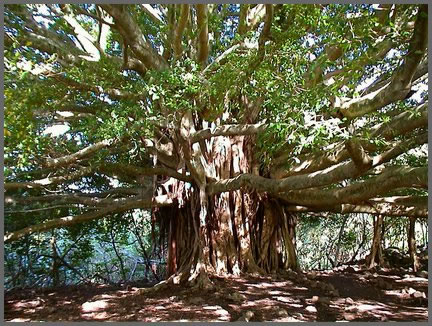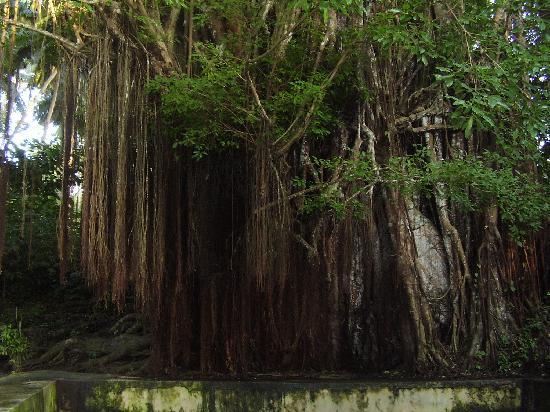|
The Balete Tree
The gnarled Balete tree can be found as wild or culture tree almost everywhere in the tropics. It is told, that already Robinson Crusoe has allegedly lived in a Balete tree. In the Philippines it grows in almost all regions pines. "Banyan-Tree" and "Balete-Tree" are also common names. The Balete tree is belonging to the family of fig trees (Ficus). About ten of 800 species are growing in the Philippines. The tree is one of the epiphytes, i.e. fruits perhaps transported by birds - can also develop on other host trees. It feeds on the substratum located there. Later, the Balete tree can crush the host tree to death. The Balete tree has a short trunk with a grey smooth bark, a broad tree top and usually grows to a height of height of 10 -20 meters. The branches are protruding and wide-ranging. From the side branches we see the development of a network of tentacle-like, downward-growing and increasingly widening aerial roots. If they have reached the ground, the tree gets a growth push and the air roots are changing into supporting roots or buttresses. Soon they integrate themselves into the main trunk and then they are hardly distinguishing from it. The root system is broad and flat. The oval-to heart-shaped leaves are as shoots reddish and then they are grow growing to leathery, green shining, six to nine centimetres long leaves. The little flowers and fruits have no special feature or use. II. Economic utilization The economic benefit is limited. The softwood of the Balete tree is not regarded as of high quality. The latex juice also contains india rubber, however, is apparently not used. From time to time ropes are manufactured from the young aerial roots. In folk medicine, the brew of the barks is used to relieve skin diseases and against worm disorders. Due to its wide treetop the Balete tree is a relatively beautiful tree, suitable for planting in avenues and parks. Older trees can be a tourist attraction. That brings us to the next chapter. III. Old and prominent tree in the Philippines Particularly three Balete trees in the Philippines are given prominence due to their age and size. At first we mention a tree in the little village Maria Aurora (Province Aurora). It is a tourist attraction and is in the glade of a Balete park. This Aurora tree reaches a height of about 65 meters. Trunk and rootstock aboveground take the considerable area of about 16 meters. It is said sixty adults are necessary to embrace it. Besides the unavoidable bird dung and spider's webs - the tree with its broad root system offers inside limited climbing possibilities, smaller caves and passages. The climbing possibilities have already led to tree damages in 2010, however. There is apparently no reliable age detail on the tree. It is only said the tree is more than 600 years old, a wording which leaves the true age open. Sometimes it is suspected the Balete-Tree in Aurora is the "oldest and biggest tree in Asia" (1). However, this assumption into can be called into question. There are for example co generic Bayan trees in India whose treetops have over 400 square meters. And botanists of the Diliman-University have determined scientifically an age of about 1360 years for another balete tree veteran in Lumabao (Province Negros). This tree grows in the municipality of Lumabao in the midst of a rice and coffee plantation. It is told, that 42 people are necessary to get their arms around the tree, twenty persons fewer compared with the obviously younger balete tree in Aurora. This tree has also a kind of cave in the tree inside. It is also called "Wonder-" or "Christmas-Tree" because at nightly hours thousands of glow-worms often fly around its foliage. There are only few data about a balete tree in the village Lazi on Siquijor. Its age is estimated to more than 4000 years. The mythical tree with its many root tentacles is sometimes considered as ghoulish and "abode of evil". At night, with its creepy extended branches and hanging roots, it can be mistaken ace a monstrous swamp creature to grab everything within its reach (2).
IV. Fairytales, creatures and enchanted places We meet the tangly grown and frightening build of the balete tree in Philippine legends again and again. The stories being connected with the tree are mostly a little horrifying. The following fairytale of Turad and Pintas makes an exception from the rule. It tells us somewhat about the surprising origin of the Balete tree. The fairytale of Turad and Pintas Once there lived the young Pintas. She was you so beautifully and gracefully that the queue of her admirers did not end. They tried to impress her with presents and performed serenades expressing their burning love to Pintas. Again and again Pintas implored her admirers to abandon her. They should hold any hope for her. Nevertheless, there were again and again new attempts of the admirers to get her favor. Anyway, she made eyes at a young neighbouring boy before. It was the strong and courageous Turad. The two fell in love. They strolled at the riverbank and picked wild flowers. "How happy they were ". But their love should still be to the test. Pintas got fickle when she met an even taller and beautiful admirer. First she hesitates and she is not answering the new love offers. But then, she gives way and she accepts the new admirer. Turad notices that Pintas shuns a meeting and later Pintas sets off to report Turad under tears of her new love. For the moment Turad feels sad. But then he gets resolute. You should not marry him! We will die together! , he exclaims with a loud voice. Suddenly the two disappeared from the ground and a big, evergreen tree grew. A tendril started to grow beside the tree. It climbed up the tree and stayed on its branches. According to the popular belief Turad became the tree and Pintas the tendril. Both together form the Balete tree now. The tree as home of the monsters Kapre and Tikbalang The Balete tree is after the Philippine mythology also residence of the bearded Kapre and the horse demon Tikbalang. The human-like Kapre reaches a height of two to three meters. The brown black, terrifically stinking body is very hairy and shaggy. The green eyes have the size of dinner plates. He likes to sit in the balete tree and there he puffs his cigars, which can reach the length of an arm. He is less malicious and can even appear friendly - particularly to women. But he also likes to play tricks so for example if he cheeps like a bird, so leading the hiker astray. The black horse demon Tikbalang is a hermaphrodite creature, half person, half horse. Head and hooves are reminding of a horse, only the body has a human shape. If he sits smoking in the brushwood, then its knees reach the head. In his physical nakedness he can also reveal his "private parts". The penetrating goat smells as well as quiet tic-tac sounds are indications for his proximity (3). V. The ghosts are still walking Nowadays, fairytales are produced by the film industry, too. In 2008 the fantasy film Dayo was presented in Manila. It shows the story of the eleven-year old Bubuy, who lights a fire in the cave of a balete tree and is pursued by the long roots of the injured tree after that. In 2006 a teenager drowned in Pasonanca in a pool. It was the seventh death by drowning in this pool. The residents of the barangay put the blame for these deaths to a balete tree, which grew nearby and demanded the cutting down (4). Finally, we want to mention the "Balete Drive" in Quezon City centre. The street is already known for a long time as a "spirit track". At nightly hours one or more "white lady(s)" are here up to mischief. Therefore it is advised not to drive there in the night. If it is unavoidable, it is recommended not to look into the outside mirror. A well-known person should sit on the back seat of the car. If these precautions are not taken, it is quite into the bounds of probability to see a female long-haired figure with a white grown. Sometimes this figure has no face, sometimes it appears with bloody face. To the final comfort we should also write, that the balete-tree is not always associated with close encounters. The tree is also regarded as an excellent recultivation tree. It is planned for example to plant around 20,000 balete trees in the village of Kapangan in the province Benguet. © Wolfgang Bethge, 2010 (1) Inquirer.net in: Strong as the "Balete", http://newsinfo.inquirer.net/inquirerheadlines/nation/view/20090619-211313/Strong_as_the_%91balete%92 (2) At night, with its creepy extended branches and hanging roots, it can be mistaken as a monstrous swamp creature out to grab everything within its reach, in: The oldest tree in Siquior, http://www.dumagueteinfo.com/oldest-tree-siquijor.php (3) cf. Wolfgang Bethge, Creatures of Midnight Philippinische Spuk- und Schreckensgestalten, in: http://bethge.freepage.de/creatures3.html (4) Balete Tree culprit in Pasonanca drowning?, in: http://www.sunstar.com.ph/static/zam/02/10/2006/feat/balete.tree.culprit.in.pasonanca.drowning.html |

